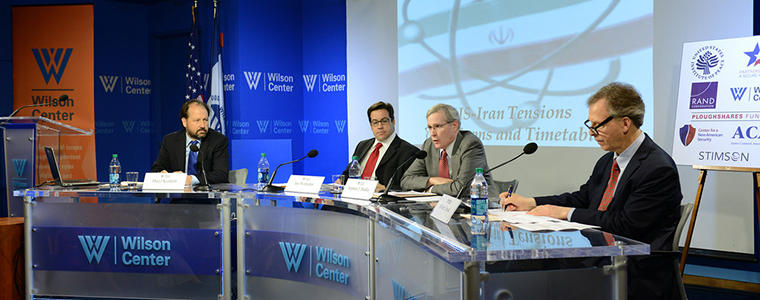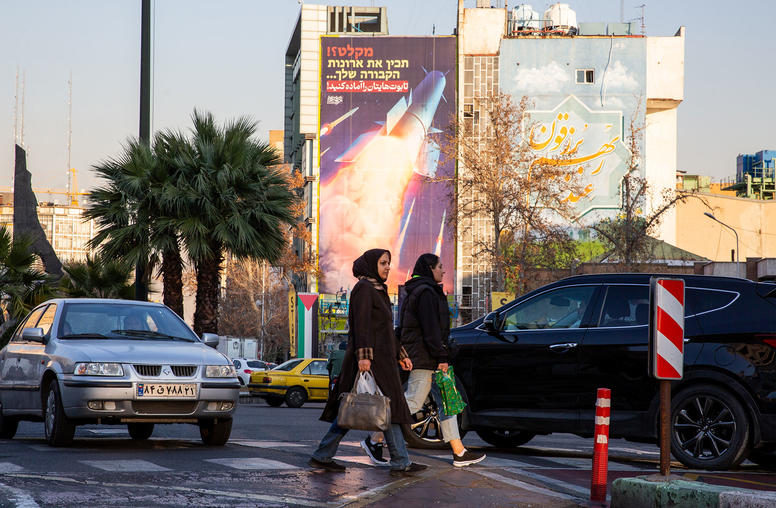Nuclear Flashpoints: US-Iran Tensions Over Timetables and Terms
Another round of diplomatic talks over Iran’s nuclear program with six world powers starts June 16. Despite the promise of a potential deal, the most recent round of negotiations exposed the still-deep divisions between the two sides on basic questions. A final agreement will have to establish timetables and settle on interpretation of terms, among other critical issues.

Remaining differences include: how many years an agreement would last and how long a deal would defer the time it would take for Iran to produce enough nuclear fuel for a bomb. The U.S. prefers an agreement that would cover decades, in contrast to Iran’s preferred timeline of a few years. The steps or phases of an agreement also are not yet clear, nor are requirements for Iranian or U.S. action.
The following are the main points from a panel discussion led by USIP Chairman and former National Security Advisor Stephen Hadley at the Woodrow Wilson International Center for Scholars. It was the second of a series of three events hosted by an unprecedented coalition of USIP, RAND, the Wilson Center, the Arms Control Association, the Center for a New American Security, the Stimson Center, the Partnership for a Secure America and the Ploughshares Fund. You can view a video of the discussion on USIP’s The Iran Primer, a web site produced in partnership with the Wilson Center.
Stephen J. Hadley, Moderator and Lead Discussant
Former National Security Advisor (2005 - 2009), Chairman of the Board of USIP
- A nuclear agreement will only mark the beginning of a decades-long process of implementation. Keeping that process on track will be a huge challenge.
- Both the U.S. and Iranian sides face enormous political challenges selling a deal at home. In Washington, issues of Congressional versus presidential prerogatives and separation of powers will be raised.
- The Obama administration will only be able to sell a deal based on enforcement and deterrence measures. It will also have to provide reassurances to regional allies that Washington is not consenting to Iranian hegemony as long as Tehran does not have nuclear weapons.
Jon Wolfsthal
Deputy Director of the Center for Nonproliferation Studies
- A nuclear deal must be able to outlast both the Obama and Rouhani administrations. Several years will be needed to regain confidence on both sides.
- A step-by-step plan is being pursued because a one-step or “front-loaded” deal would not be viable or sustainable. But major sections relief up-front would build incentives for Iranian compliance.
- An Iran deal is about linking uranium enrichment and sanctions relief to milestones —and Iran coming clean on past activities.
- Placing permanent restrictions on Iran is not an option because Iran wants to eventually be treated as any other member of the Nuclear Non-Proliferation Treaty.
- Iran wants to end its international isolation, which may give the United States leverage.
- A key difference between Iran and North Korea is that some parts of Iranian society want to engage with the outside world and are open to relations with the United States.
- Possible pitfalls to a deal include allegations of secret facilities and ongoing weapons research.
- New imposition of non-nuclear sanctions such as those currently being considered by the U.S. Congress could impact the negotiating or implementation of a deal.
- The two sides seem unlikely to negotiate a deal by July 20. That is not necessarily a bad thing. But the limits of political trust will be tested if that timetable is extended for six months and a deal still is not reached by the end of the lengthened period//.
Daryl Kimball
Executive Director of the Arms Control Association
- Since 2007, U.S. intelligence has concluded that Iran has the capacity to produce nuclear weapons--if it chooses to do so. Tehran’s acquired nuclear knowledge cannot be easily destroyed.
- A deal would not be built on trust, but on verification. The United States, for example, does not trust Russia but is able to work with it on issues of common concern.
- A viable deal would establish verifiable limits on Iran’s program that will substantially increase the time it would take Tehran to build nuclear weapons. A comprehensive deal will also decrease the time necessary to detect and disrupt a breakout attempt.
- A comprehensive deal would roll back Iran’s uranium enrichment capacity, block a plutonium path to a bomb and enhance the U.N. inspections regime.
- Producing enough enriched uranium would overcome a key hurdle to Iran building a bomb. But Iran also would need to design and construct a nuclear device, integrate a warhead into a delivery system, and possibly conduct several explosive tests.
- Iran would need two to three months to produce one bomb’s worth of weapons-grade uranium with its current stockpile and operating centrifuges.
- Possible options for capping Iran’s enrichment capacity include banning enrichment beyond the 5 percent level indefinitely and limiting the size of Iran’s stockpile to near zero indefinitely. Also, enrichment at the Fordow facility could be halted.
- Rouhani may find it politically impossible to admit Iran had a nuclear weapons program in the past.
Robert Litwak
Vice President for Scholars and Academic Relations and Director of International Security Studies at the Wilson Center
- For Iran, the nuclear issue is a proxy for a broader debate about Tehran’s relationship with the outside world.
- For the U.S., the nuclear issue is a surrogate for how Washington deals with rogue or outlier states generally.
- Supreme Leader Ayatollah Ali Khamenei seems concerned that the nuclear issue is a slippery slope and that a deal could lead to more demands from the U.S. on other issues, such as human rights.
- Iran does not necessarily have realistic expectations of the U.S. and has not revealed what it would be willing to give up for sanctions relief.
- Obama’s two-track strategy of pressure and engagement has sharpened the choice for Iran. The alternatives to a deal are not good for either side.
- Iran will need to weigh the domestic political cost and possible risk of regime legitimacy against the economic benefits of sanctions relief.
- Sanctions relief could be phased in, beginning with presidential waivers and later through congressional action.
- Even if Iran complies on the nuclear issue, other issues will remain, such as human rights violations and state sponsorship of terrorism. Disentangling the sanctions will be difficult.
- Iran does not currently perceive an existential threat that necessitates nuclear weapons for protection.
To assess this period of pivotal diplomacy, the coalition of eight Washington policy organizations is hosting these three discussions to coincide with the last three rounds of talks. For a rundown of the first event on the disparate issues to be resolved and the many formulations for potential solutions, see this earlier post on The Olive Branch. U.S.-Iran tensions over timetables and terms of the negotiations are outlined in this factsheet.
Garrett Nada is a senior program assistant for Iran and Middle East programs at USIP.



